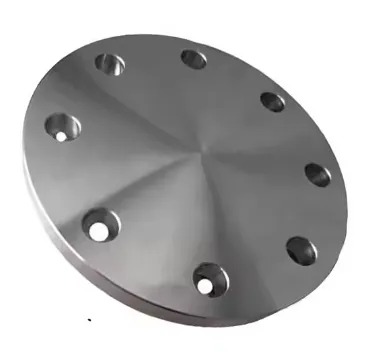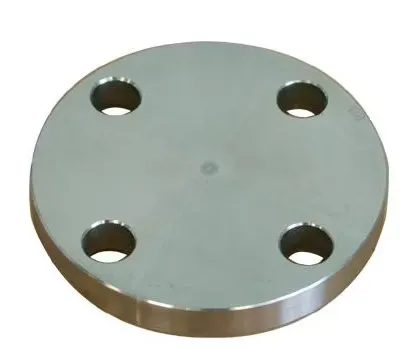"JIS 10K SS400 BL Flange" refers to a blind flange that complies with the Japanese Industrial Standard JIS, has a pressure rating of 10K, and is made of SS400. The following is a brief introduction:
Fa'amatalaga Fa'atonu
JIS Standard: JIS has clear regulations on the size, tolerance, material, performance and inspection methods of flanges, ensuring the quality and interchangeability of the product so that the flange can be widely used in Japan and areas that adopt JIS standards.
Dimension Specifications: According to the JIS standard, its size corresponds to the nominal diameter, covering a variety of specifications from smaller diameters to larger diameters, such as DN15 - DN600, etc. Different nominal diameters correspond to different dimensional parameters such as outer diameter, inner diameter, thickness and bolt-hole distribution.
Meafaitino
Chemical composition: SS400 is a common structural steel. Its main chemical components include carbon (C), silicon (Si), manganese (Mn), phosphorus (P), sulfur (S), etc. The carbon content is generally around 0.2%, the manganese content is 0.6% - 1.5%, the silicon content is around 0.3%, and the phosphorus and sulfur content is relatively low to ensure the performance of the steel.
Mea fa'ainisinia: It has good strength and toughness, the tensile strength is not less than 400MPa, the yield strength is generally around 235MPa, and the elongation is not less than 21%. It can withstand certain pressures and external forces and is suitable for a variety of pipeline connection occasions.
Processing performance: SS400 has good processing performance. It can be made into a blind flange that meets the requirements through various processing methods such as forging, rolling, cutting, and welding, which can adapt to different manufacturing processes and engineering requirements.
Vaega fa'avae
Blind plate structure: BL is a blind plate. This flange has no through hole in the middle. It is used to block the end of the pipe, isolate and cut off the medium, and ensure the safety and sealing of the pipeline system.
Fa'amaufa'ailoga luga: Common ones include raised surface (RF) and flat surface (FF). The appropriate sealing surface form can be selected according to the specific sealing requirements and working conditions to ensure good sealing performance.
Nofoaga fa'aoga
General industrial pipelines: In general industrial fields such as chemical, petroleum, electric power, and metallurgy, it is used for the ends of pipes that do not require medium circulation, such as the inspection port of equipment and the end of the pipe, which is convenient for equipment maintenance and management of the pipeline system.
Water supply and drainage system: In urban water supply and drainage, building water supply and drainage and other systems, it is used to block the end or branch of the pipe, which is convenient for the installation, maintenance and debugging of the pipe.
HVAC system: In the HVAC pipeline system, it is used to close the pipe part that does not require medium flow, such as the end of the system, the blocking of branch pipes, etc., to ensure the normal operation and adjustment of the system.
When choosing flanges for industrial applications, it's essential to understand the differences between various flange standards. The JIS 10K SS400 BL flange is a popular choice in Japan and worldwide, especially in industries like construction, oil and gas, and water treatment. But how does it compare to other flange standards like ANSI, DIN, or ASME?
SS400 Flange is made from carbon steel, known for its balance of strength and ductility. The JIS 10K standard, part of the Japanese Industrial Standard (JIS), specifies flanges rated for pressures up to 10 MPa (megapascals). These flanges are often used in low-pressure systems and are ideal for handling fluids in mild conditions. The JIS 10K flange is also prized for its affordability and ease of use in general industrial environments.
In comparison, ANSI flanges, particularly the ANSI 150, are often used in the United States and have a different pressure rating system, often involving higher pressure capacities. ANSI 150 flanges, for example, are rated for pressures up to 285 psi at room temperature, which is typically higher than the JIS 10K SS400 flanges' rating.
DIN flanges are common in Europe and are standardized under the Deutsches Institut für Normung (DIN). These flange for sale are known for their precision and compatibility across various industries. While the pressure ratings may be similar to JIS 10K, DIN flanges often have more stringent dimensional tolerances and are often used in high-pressure or high-temperature applications.
One of the key advantages of the JIS 10K SS400 flange over other standards is its cost-effectiveness, especially for industries operating in moderate pressure systems. However, for applications demanding higher pressure ratings or more precise specifications, ANSI or DIN flanges may be preferred.
In conclusion, selecting the right flange depends on pressure requirements, material compatibility, and industry standards. For most standard applications, the SS400 flange under the JIS 10K standard offers a reliable and affordable option.
JIS 10K SS400 BL flanges are increasingly recognized as the ideal choice for high-pressure applications due to their superior material properties and design features. Constructed from SS400 steel, these flanges offer excellent strength and durability, making them suitable for demanding environments where reliability is critical.
One of the primary reasons JIS 10K SS400 BL flanges excel in high-pressure settings is their robust structural integrity. SS400 is a low-carbon structural steel that provides a good balance of tensile strength and ductility. This balance allows the flanges to withstand significant pressure without deforming or failing, thus ensuring a safe and secure connection in piping systems. Additionally, the flanges are designed to meet Japanese Industrial Standards (JIS), ensuring high-quality manufacturing processes that enhance their performance and longevity.
Moreover, the 10K rating indicates that these flanges can handle pressures up to 10 MPa (approximately 1,450 psi), which is essential for applications in industries such as oil and gas, petrochemical, and power generation. The ability to maintain a tight seal under high pressure minimizes the risk of leaks, which can be costly and hazardous.
Another advantage of JIS 10K SS400 BL flanges is their versatility. They can be used with various gasket materials, allowing for customization based on the specific requirements of different fluids and pressure levels. This adaptability facilitates their use in a wide range of scenarios, from high-temperature steam pipelines to agitated liquid systems.
In conclusion, JIS 10K SS400 BL flanges are ideal for high-pressure applications due to their excellent material properties, adherence to stringent manufacturing standards, and versatility. Their strength and reliability make them a preferred choice for engineers and industry professionals seeking durable solutions in challenging environments.

















